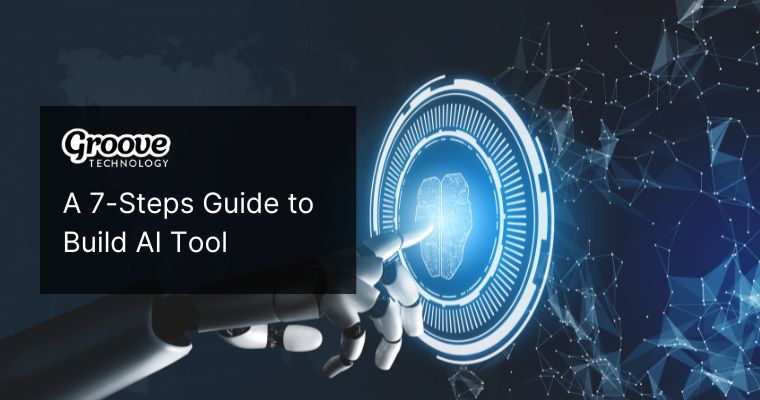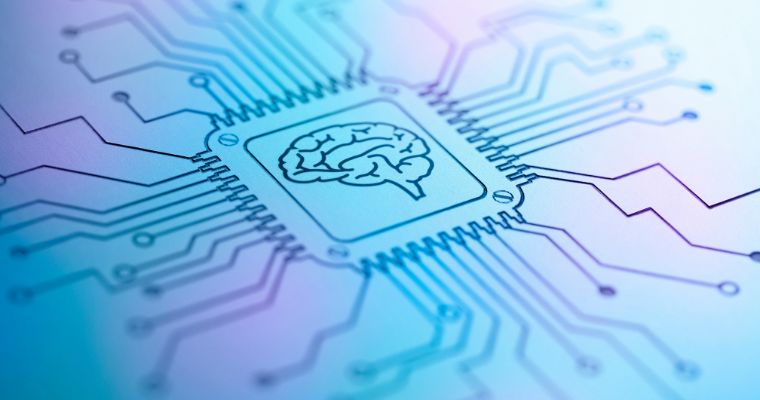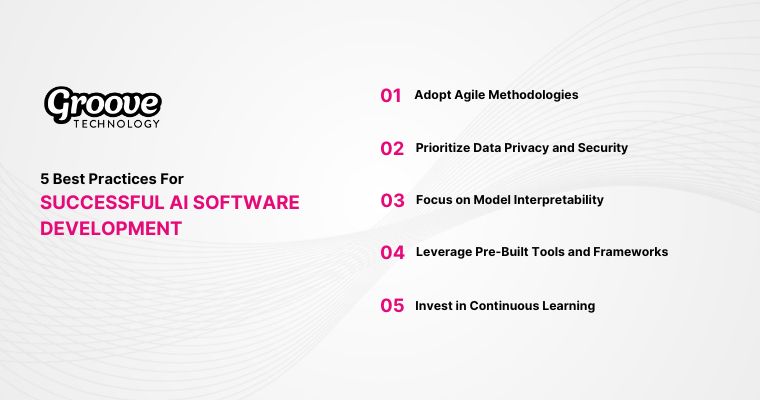The Ultimate Guide to Developing AI Software and Systems
Developing AI tools is a journey that requires multi-dimensional integration between data science, software engineering, and domain expertise. The process is structured into 7 key stages, from strategy formulation to implementation and continuous optimization.
This article analyzes in-depth the process of building an AI system, focusing on the implementation and operation steps in a real environment. The implementation stage plays a decisive role, transforming AI models from concepts to solutions that have a direct impact on business operations and decision making.
In addition to the 7 foundational steps, we also analyze important factors and best practices in AI development. With a portfolio of more than 120 successful projects and a 97% customer retention rate, Groove Technology affirms its position as a trusted partner in providing customized AI solutions.
The journey of building AI starts with identifying specific pain points. Next comes the process of data collection and preprocessing, selecting the appropriate algorithm, training and evaluating the model. The deployment and integration phase requires synchronization between stakeholders to ensure the system operates effectively in the production environment.
Let's explore each step in the AI tool development process and strategic insights to create AI solutions that bring practical value.

7 Steps to Build a Successful AI Tool
To build a successful AI software, you need to follow these 7 steps:

Step 1: Define Your AI Project Objectives
Starting AI software development begins with crystal-clear objectives. A defined purpose provides a roadmap aligning with business strategies.
1. Identifying the Problem
Clarify the issue or opportunity AI can address:
- Business Needs: Focus areas could include automating tasks, enriching customer interactions, or predictive analytics.
- Feasibility: Evaluate data accessibility and problem complexity to ensure AI is a viable solution.
2. Setting Measurable Goals
Success hinges on precise targets:
- SMART Goals: Define specific, measurable, achievable, relevant, and time-sensitive objectives.
- Key Metrics: Include indicators like system accuracy, speed, and customer satisfaction.
3. Resource Planning
Assess the resources necessary for implementation:
- Tech Stack: Identify tools, platforms, and infrastructure essential for the project.
- Human Capital: Build a team with AI, data science, and domain-specific expertise.
- Budget: Outline costs covering development to deployment.
Laying this groundwork ensures focus and efficiency for the subsequent phases of AI development.
Step 2: Gather and Prepare Data
Data is the cornerstone of any AI system. The quality and relevance of your data directly impact the effectiveness of your AI software.
1. Data Collection Strategies and Best Practices
Implement effective data collection methods:
- Internal Data: Utilize existing data from your organization's databases and systems.
- External Data: Source data from public datasets, third-party providers, or web scraping, ensuring compliance with data privacy laws.
- Data Augmentation: Enhance your dataset by generating additional data through techniques like data augmentation or simulation.
2. Data Cleaning and Preprocessing Techniques
Prepare your data for analysis:
- Cleaning: Remove duplicates, correct errors, and handle missing values to ensure data integrity.
- Normalization: Scale data to a standard range to improve model performance.
- Feature Engineering: Create new features or modify existing ones to better represent underlying patterns.
3. Ensuring Data Quality and Relevance
Maintain high data standards:
- Relevance: Ensure the data aligns with the problem you're addressing.
- Accuracy: Verify the correctness of data entries.
- Timeliness: Use up-to-date data to reflect current trends and behaviors.
Investing time in meticulous data gathering and preparation sets the stage for building a robust AI model that delivers accurate and reliable results.
Step 3: Choose the Right AI Technologies and Tools
Data forms the bedrock of AI systems, with its quality and relevance profoundly affecting outcomes.
1. Effective Data Collection Approaches
- Internal Sources: Harness organisational databases and systems.
- External Sources: Acquire datasets via public repositories, vetted third-party vendors, or compliant web scraping.
- Data Augmentation: Generate supplemental data using techniques like augmentation or simulations.
2. Data Preparation Best Practices
- Cleaning: Eliminate redundancies, correct inaccuracies, and manage missing values to uphold data integrity.
- Normalization: Standardise data scales to enhance algorithmic efficiency.
- Feature Engineering: Develop or refine attributes to better encapsulate patterns.
3. Ensuring Data Fitness
- Relevance: Align data precisely with the problem domain.
- Accuracy: Rigorously validate entries for correctness.
- Timeliness: Incorporate up-to-date data to mirror current scenarios.
Investing in meticulous data curation lays the foundation for robust and dependable AI models.
Step 4: Design and Develop Your AI Model
With objectives defined, data prepared, and tools selected, the next step is to design and develop your AI model.
1. Architecting the AI Model Structure
Design the model's architecture to suit your problem:
- Neural Networks: For complex tasks like image and speech recognition, consider deep learning architectures.
- Decision Trees: Useful for classification and regression tasks with interpretable outputs.
- Support Vector Machines: Effective for classification tasks with clear margin separation.
2. Implementing Feature Engineering
Enhance model performance through feature engineering:
- Feature Selection: Identify and select the most relevant features to reduce dimensionality and improve efficiency.
- Feature Creation: Develop new features that capture underlying trends or patterns in the data.
3. Training and Fine-Tuning the Model
Train your model to learn from data:
- Training: Use your prepared dataset to teach the model, adjusting parameters to minimize errors.
- Validation: Evaluate the model on a separate dataset to tune hyperparameters and prevent overfitting.
- Testing: Assess the model's performance on unseen data to estimate real-world effectiveness.
- Fine-Tuning: Adjust the model based on testing outcomes to enhance accuracy and generalization.
A well-designed and thoroughly trained AI model serves as the core of your AI software, capable of delivering insights and automating tasks as intended.
Step 5: Test and Validate Your AI Software
Ensuring the reliability and effectiveness of your AI software requires rigorous testing and validation.
1. Conducting Thorough Testing Procedures
Implement comprehensive testing strategies:
- Unit Testing: Verify individual components function correctly.
- Integration Testing: Ensure different modules work together seamlessly.
- System Testing: Assess the complete system's performance under various conditions.
2. Evaluating Model Performance and Accuracy
Evaluating the performance of your AI model is a critical step to ensure it meets the desired goals and provides reliable outputs. This involves using metrics and techniques that assess how accurately and efficiently your model operates under various conditions.
Key Performance Metrics
Different metrics help evaluate your model's effectiveness based on the problem it's solving:
- Classification Tasks:
- Accuracy: Measures the percentage of correctly classified instances out of the total instances.
- Precision: Indicates how many of the predicted positive results are true positives.
- Recall (Sensitivity): Reflects the ability of the model to identify all relevant instances (true positives).
- F1 Score: A harmonic mean of precision and recall, balancing the two metrics.
- ROC-AUC (Receiver Operating Characteristic – Area Under Curve): Evaluates the model's ability to distinguish between classes at various threshold levels.
- Regression Tasks:
- Mean Absolute Error (MAE): The average magnitude of errors between predicted and actual values.
- Mean Squared Error (MSE): Penalizes larger errors more heavily, useful for sensitive predictions.
- R-squared (Coefficient of Determination): Indicates the proportion of the variance explained by the model.
- Clustering Tasks:
- Silhouette Score: Measures the cohesion and separation of clusters.
- Dunn Index: Assesses the quality of clustering by considering the ratio of the smallest inter-cluster distance to the largest intra-cluster distance.
Stress Testing
Evaluate the robustness of your AI system under different scenarios:
- Adversarial Testing: Simulate edge cases or intentionally introduce noisy data to test resilience.
- Load Testing: Assess performance when handling high volumes of data or traffic.
- Generalization Testing: Verify how well the model performs on new, unseen datasets.
3. Addressing Bias and Ethical Considerations
AI models are prone to biases, often introduced through data collection or algorithm design. These biases can lead to unfair or incorrect predictions, which may harm certain user groups or result in unethical outcomes.
Common Sources of Bias
- Sampling Bias: When the training data doesn't represent the target population adequately.
- Labeling Bias: Errors or subjectivity in the labeling process of the dataset.
- Algorithmic Bias: Bias introduced by the choice of algorithms or the assumptions they make.
Mitigation Strategies
- Balanced Datasets: Ensure diverse and representative training data.
- Fairness-Aware Algorithms: Use algorithms designed to minimize bias.
- Regular Audits: Continuously test the model for unintended biases using fairness metrics like disparate impact ratio or demographic parity.
By proactively addressing bias, you create an ethical AI system that fosters trust and delivers equitable results.
Step 6: Deploy and Integrate Your AI Solution
Once your AI model has been tested and validated, it's time to deploy it for real-world use. Deployment involves ensuring that the AI system integrates seamlessly into existing workflows and operates reliably in production environments.
1. Preparing for Production Deployment
- Environment Selection: Choose between cloud, on-premises, or hybrid deployments based on scalability and security needs.
- Containerization: Use tools like Docker to encapsulate the model and its dependencies for easier deployment.
- Pipeline Automation: Implement CI/CD pipelines to streamline updates and iterations.
2. Integrating AI into Existing Workflows
- API Integration: Expose the model as a service through REST or GraphQL APIs.
- Workflow Alignment: Train end-users and adapt operational processes to incorporate AI capabilities.
3. Ensuring Scalability and Reliability
- Elastic Infrastructure: Leverage cloud services with auto-scaling to manage varying workloads.
- Monitoring Tools: Set up tools to track performance metrics, detect anomalies, and ensure uptime.
Deployment is a critical milestone where AI transitions from a concept to an actionable solution, impacting real-world operations and decision-making.
Step 7: Monitor, Maintain, and Improve Your AI Software
After deploying your AI solution, the journey doesn’t end. Continuous monitoring, maintenance, and improvement are essential to ensure the system operates optimally, adapts to new challenges, and remains aligned with evolving user needs and technological advancements.
1. Implementing Continuous Monitoring Systems
Monitoring systems help track the performance and health of your AI software in real-time. This ensures any issues are identified and addressed promptly, minimizing disruptions.
- Performance Metrics: Set up dashboards to track metrics such as latency, throughput, and prediction accuracy.
- Error Tracking: Implement error-logging tools to capture anomalies or failures in model predictions.
- User Feedback: Integrate mechanisms to collect user feedback for insights into system usability and effectiveness.
- Automation: Use tools like Prometheus, Grafana, or ELK stack to automate monitoring and alerting.
2. Performing Regular Maintenance and Updates
AI systems must evolve to remain effective in dynamic environments. Regular maintenance ensures the software adapts to changes in data, user behavior, and business requirements.
- Retraining Models: Update models periodically with fresh data to maintain relevance and accuracy.
- System Updates: Apply patches and updates to the underlying infrastructure and dependencies to enhance security and performance.
- Data Audits: Regularly review and clean the training dataset to address any shifts or biases introduced over time.
3. Iterating and Enhancing Based on Real-World Performance
Use real-world insights to drive iterative improvements in your AI solution. This process ensures that your software evolves alongside user expectations and technological trends.
- A/B Testing: Experiment with different model versions or configurations to identify enhancements.
- Feature Expansion: Add new functionalities based on user needs or market demands.
- Explainability Enhancements: Improve transparency by incorporating explainable AI (XAI) tools, helping stakeholders understand the model’s decision-making process.
By implementing robust monitoring systems, maintaining your AI software, and continuously improving its capabilities, you ensure the long-term success and reliability of your AI solution. This phase not only sustains operational excellence but also provides a foundation for innovation and scalability.
Essential Considerations for AI Software Development
Creating AI software is a complex process that requires navigating unique challenges and tailoring development practices to the nuances of artificial intelligence. By addressing these considerations upfront, businesses can streamline the development process and maximize the impact of their AI solutions.
- Data Quality and Accessibility: High-quality data is the foundation of any AI system. Insufficient, biased, or outdated data can lead to inaccurate or unfair outcomes.
- Computational Requirements:AI development, particularly for large-scale models, demands significant processing power. Cloud computing solutions like AWS and Azure can help alleviate resource constraints but may increase operational costs.
- Ethical and Legal Compliance: Ensuring ethical AI practices involves addressing issues like bias, transparency, and privacy. Compliance with laws such as GDPR is crucial to avoid reputational and legal risks.
- Integration into Existing Systems: Many organizations struggle to integrate AI tools into their current workflows and legacy systems, which can lead to inefficiencies.
- Scalability: As businesses grow, AI systems must be capable of handling increased workloads and more complex datasets.

Differences Between AI and Traditional Software Development
- Learning-Based vs. Rule-Based: Traditional software executes predefined rules, while AI systems learn patterns from data to make decisions.
- Continuous Improvement: AI requires ongoing training and iteration, unlike traditional software which typically follows a linear development cycle.
- Probabilistic Outputs: AI provides likelihood-based results (e.g., a 90% probability of rain), contrasting with the deterministic results of traditional systems.
Skills Required for AI Software Development
Developing AI software necessitates a multidisciplinary team with diverse expertise:
| Role | Core Skills | Tools & Technologies |
| AI Engineer | Deep learning, ML frameworks | TensorFlow, PyTorch |
| Data Scientist | Data preprocessing, analytics | Pandas, Scikit-learn, NumPy |
| Software Dev | API integration, deployment | Docker, Kubernetes |
| Domain Expert | Business knowledge | Industry-specific platforms |
5 Best Practices for Successful AI Software Development
To ensure effective AI software development, adhering to proven best practices is critical. These strategies foster innovation while maintaining efficiency and compliance.

1. Adopt Agile Methodologies
AI projects benefit from the flexibility of agile development:
- Iterative Testing: Continuously evaluate models to adapt to changing requirements.
- Cross-Team Collaboration: Foster communication between data scientists, engineers, and business stakeholders.
2. Prioritize Data Privacy and Security
Protecting user data and ensuring compliance with privacy laws are essential for trustworthiness:
- Use encryption and access controls to safeguard sensitive information.
- Regularly audit data pipelines for vulnerabilities and compliance with regulations like GDPR and CCPA.
3. Focus on Model Interpretability
- Incorporate explainable AI (XAI) tools to clarify decision-making processes, especially for stakeholders and regulators.
- Example: Implement LIME or SHAP to visualize the impact of different features on predictions.
4. Leverage Pre-Built Tools and Frameworks
Using established frameworks saves time and resources:
- Tools: TensorFlow, PyTorch, and Scikit-learn for machine learning tasks.
- Cloud Platforms: AWS SageMaker, Google AI, and Azure for scalable deployment.
5. Invest in Continuous Learning
- Regularly retrain models with updated data to maintain accuracy and relevance.
- Establish feedback loops to incorporate real-world performance improvements.
Case Study: Amazon’s recommendation engine thrives on constant refinement, leveraging user interactions to personalize suggestions in real-time.
Groove Technology’s Expertise in AI Software Development
Groove Technology partners with enterprises to design and deliver bespoke AI software solutions. By combining deep technical knowledge with a collaborative approach, Groove empowers organisations to achieve measurable success through technology.
Why Collaborate with Groove Technology?
- Verified Expertise: Completed over 120 projects with an impressive 97% client retention rate.
- Elite Workforce: A team of 230+ specialists excelling in AI, machine learning, and tailored development solutions.
- Holistic Services: Offering full-stack development, IoT integration, advanced data analytics, and more.
Tailored Support for AI Implementation
- Custom AI Development: Addressing diverse business challenges through predictive modelling, automation, and optimisation.
- Flexible Collaboration Models: Select staff augmentation or dedicated teams to suit your project's scale and requirements.
- Continuous Support: From maintenance to updates, ensuring your AI solutions evolve with market demands.
Choosing Groove Technology provides a pathway to success in AI, fostering innovative growth and operational excellence. Partner with Groove to harness the potential of cutting-edge technology while maintaining flexibility and control.

FAQs
How Is the AI Development Lifecycle Unique Compared to Traditional Software Development?
The AI development lifecycle diverges from traditional software development through its dependency on high-quality datasets and its adaptive framework.
| Aspect | AI Development | Traditional Software Development |
| Data Reliance | Requires vast datasets for training models. | Operates on predefined, static business logic. |
| Outcome Nature | Outputs are probabilistic, relying on patterns. | Outputs are predictable and deterministic. |
| Validation | Continuous validation with real-world data. | Relies on static, functional tests. |
Unlike rule-based systems, AI models necessitate regular retraining to align with dynamic environments.
What Distinguishes AI Development in Startups Versus Enterprises?
The disparity arises from variations in scale, agility, and resources.
| Factor | Startups | Enterprises |
| Budget | Limited, necessitating lean prioritisation. | Larger budgets allow bespoke solutions. |
| Agility | Focusses on rapid iterations. | Faces slower cycles due to layered approvals. |
| Talent | Generalist teams handling broad tasks. | Specialist teams with domain-specific skills. |
Startups often leverage tools like AutoML for speed, while enterprises invest in tailored AI solutions to meet complex needs.
Can Small Teams Build Effective AI Solutions?
Yes, small teams can harness pre-trained models, open-source frameworks, and cloud-based platforms to develop scalable AI solutions cost-effectively.
AI software development is a complex process but can be very valuable if done correctly. In this article, we have explored seven key steps from defining goals, preparing data, selecting technology, designing and deploying to maintenance and continuous improvement.
Groove Technology is proud to provide customized AI development solutions that meet your business needs. Don’t forget to check out our other blogs to learn more about AI technology and software innovation!




